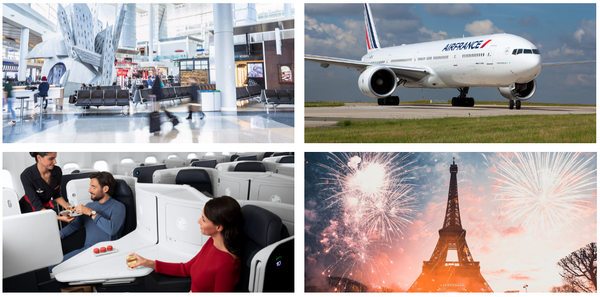Case Study: How a 3-Person Accounting Firm Turned $75K/Month in Spend into $40K in First-Class Travel
A firm’s next first-class ticket was buried in their SaaS bill. See how three accountants flipped $75K in monthly spend into $40K of luxury travel—no extra dollars, just smarter cards. (BLUF: ...If you’re still taking 1-2% cash back, you’re burning money)

📍 Industry: Accounting
👥 Company Size: 3 full-time partners
💳 Monthly Spend: $75,000+
🏁 Pre-UpNonStop Return: 1.3% cash back
✈️ Post-UpNonStop Return: ~$40,000/year in travel value (~4.4% ROI)

Your trust is worth more than a logo on our wall...
We take our client NDAs seriously. So instead of showing off logos, we’re showing you what really counts: how much our clients saved, earned, and unlocked through smarter spend. No fluff, just the good stuff — with their privacy fully intact.
Introduction
Every boutique professional-services firm knows that keeping billable work flowing is priority one. What slips through the cracks—far too often—is the quiet, continuous leak that happens when credit-card rewards are treated as trivia. This case study examines how a three-partner accounting practice stopped ignoring rewards, partnered with UpNonStop, and—within nine months—converted routine operating expenses into a steady pipeline of first- and business-class travel that delights both clients and firm owners.
The Pre-UpNonStop Reality
An Uncoordinated Card Stack
Each partner carried an individual American Express Blue Business card. None linked to a shared central account. Recurring software subscriptions, continuing-education costs, cloud-hosting invoices, client gifts, and the firm’s modest advertising budget spilled across three separate statements.
Treating Rewards Like Rounding Errors
The partners had configured automatic redemptions for 1 % or 1.3 % cash back and never logged in to monitor balances. Points sat idle, occasionally credited against future statements in amounts so small they never appeared in internal reporting.
Consequences
- No Unified Spend Policy – Administrative staff had no guidance on which card to use for which purchase.
- No High-Value Redemptions – In three years, not a single award flight, hotel night, or transfer partnership had been tapped.
- Missed Category Multipliers – Cloud services, digital ads, and professional-services software earn 3–4 × points with the right card, but the firm captured only 1 ×.
UpNonStop Enters the Picture

Discovery Session
UpNonStop began with a two-hour discovery call. The agenda: map every expense stream, clarify the partners’ travel goals (Europe yearly, U.S. conferences quarterly), and audit the existing card mix.
Month 1 – Optimization & Setup
- Centralized Billing – All recurring vendors shifted to a shared corporate wallet. Each partner and the office manager received role-based virtual cards with spend limits.
- Two-Card Core
- American Express Business Gold for 4 × points on top two monthly categories (consistently: U.S. advertising and computer software).
- Capital One Spark Cash Plus for uncapped 2 % cash back—rebated as Venture Miles when advantageous—and for high-dollar vendor invoices that charge credit-card fees.
- Stripe Corporate Card layered on for certain payment processors, unlocking fee credits and granular real-time controls.
Month 2 – Policy & Education
- Written Points Policy – One partner became “points CFO,” empowered to approve or decline flight and hotel redemptions.
- Monthly Slack Digest – Automated snapshot of balances, upcoming travel needs, and soon-to-expire credits.
- All-Hands Workshop – 45-minute lunch-and-learn on why transferable points beat fixed-value redemptions.
Ongoing – Award Booking Strategy
- Portal vs. Transfer Rule – If portal booking produced < 2.5 ¢ per point, points remained banked. Otherwise, partners transferred to airline or hotel programs.
- Preferred Transfer Partners – Avianca LifeMiles, Emirates Skywards, Singapore KrisFlyer for long-haul premium cabins; Virgin Atlantic Flying Club for opportunistic Delta One deals.
- Family Pooling – Partners linked household frequent-flyer accounts to widen inventory and avoid orphaned balances.
Year-One (9 months in) Results

Quantitative Outcomes
| Metric | Before UpNonStop | After UpNonStop (9 months in) |
|---|---|---|
| Return on Spend | 1.3 % cash back | 4.4 % average travel value |
| Annual Rewards Value | ~$11,700 (cash) | ~$40,000 (premium cabin travel) |
| First- or Business-Class Flights | 0 | 6+ international J-class seats |
| Redemption Methods | None | Mixed portal bookings & transfers |
*scroll left to right ↔️ if viewing on mobile device ☝🏻
Qualitative Wins
- Mindset Shift – Partners now treat points as an asset class with a quarterly report line, right beside cash yield on bank balances.
- Client-Facing Upgrades – Travel in lie-flat seats lets partners arrive fresh for on-site audits, creating a premium impression that feeds referrals.
- Operational Clarity – A single dashboard shows spend by vendor, card, category, and employee, simplifying accruals and budgeting.
Highlighted Redemptions
Emirates First—New York to Dubai
- Cost: 150,000 Emirates Skywards miles round-trip after a 25 % Amex → Emirates transfer bonus.
- Cash Price Equivalent: ≈ $11,000.
- Net Point Value: 7.3 ¢ per point—more than five times the firm’s old 1.3 % cash-back baseline.
DeltaOne Retreats
Three separate Delta One seats, each booked via “Pay with Points” on the Amex travel portal and benefiting from the 35% Business Platinum rebate (a card held personally by one partner). Net cost per seat averaged 105,000 Membership Rewards after rebate, versus cash fares near $4,000.
End of Year London Trip
All three partners flew business class JFK-LHR, then redeemed Capital One miles via the portal for a boutique Marylebone hotel. Conference-week rates sat at $680/night, but points outlay reflected a comfortable 2¢ per mile valuation.
Partner Perspective
“We used to joke that points were Monopoly money. UpNonStop showed us they were more like an unclaimed Treasury bond—valuable, but invisible without the right process. For the first time, card rewards contribute tangibly to partner compensation and firm culture.”
Lessons for Other Small–Mid Businesses
1. Centralize, Then Optimize
Start by corralling every dollar of card spend under a unified strategy; then chase multipliers. Fragmented spend sabotages both statement credits and the quality of reporting.
2. Assign Ownership
An individual—or an external adviser—must control transfers, monitor expirations, and police redemptions. Democracy in points programs sounds polite but breeds neglect.
3. Pair Education With Policy
Even a ten-minute quarterly recap keeps staff aligned and sparks ideas for future trips, ensuring rewards stay top of mind.
4. Track ROI Like Any Asset
Monthly dashboards, posted where leadership already looks at P&L, cement the idea that points are measurable returns—not perks.
The UpNonStop Framework Summarized
- Audit – Where, how, and why is money leaving your accounts?
- Align – Match card multipliers to those spend buckets.
- Automate – Use role-based cards and spend controls to protect the plan.
- Report – Surface balances, expiring credits, and booking windows in tools your team already uses.
- Redeem Intelligently – Portal when valuation is strong; transfer when aspirational seats appear.
Follow these steps and the leap from 1-2% cash back to 4–5% in travel value is not exceptional—it is predictable.
Conclusion: Your Dormant Asset Awaits
If your business charges $50,000 or more to credit cards every month, you are sitting on a silent, compounding balance sheet item. Points are not vapor; they are currency with purchasing power that—used wisely—elevates client perception, employee satisfaction, and owner lifestyle without adding overhead.
UpNonStop unlocked $40,000+ in premium travel for a three-partner accounting firm without changing vendors, cutting budgets, or increasing spend.
Ready to Transform Expenses into Experiences?
Reach out for a complimentary spend audit. In less than a week, you will know exactly how many business-class tickets you have been leaving on the table—and how quickly you can claim them.




